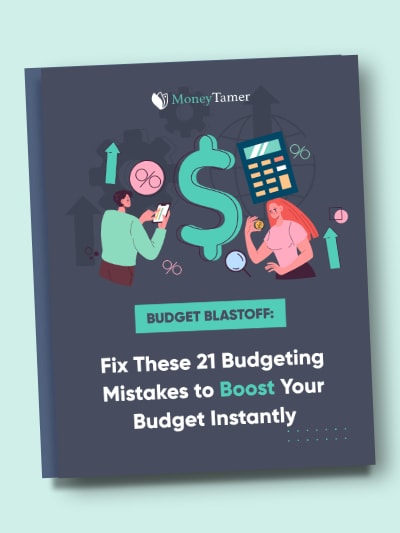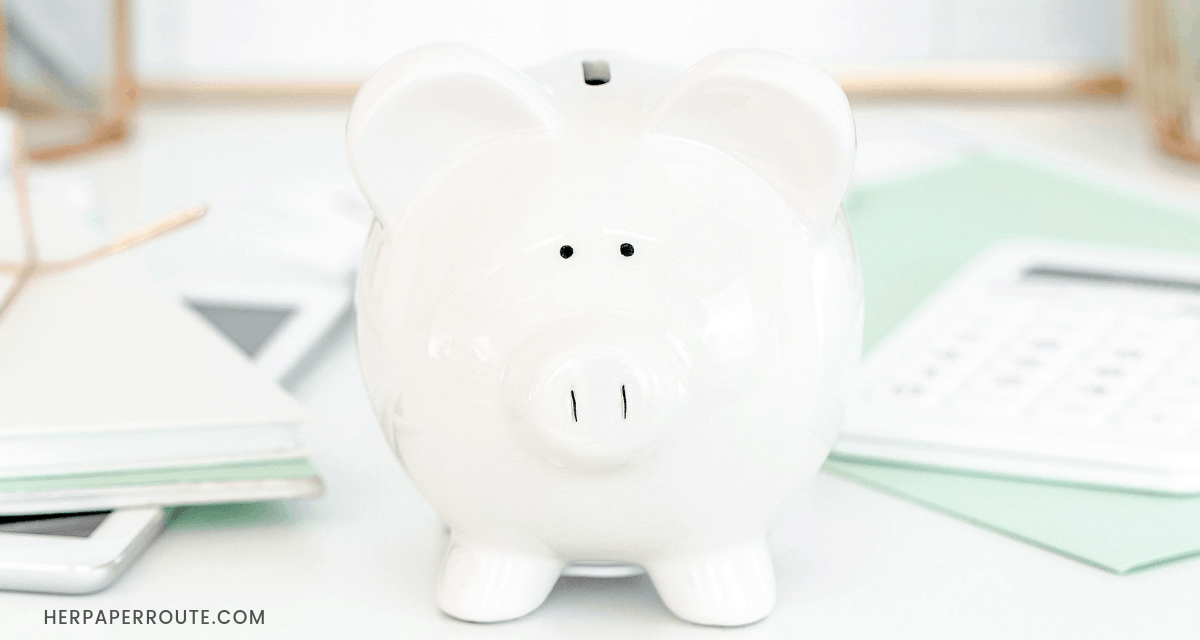Will the 30-30-30-10 Budget Rule Work for You?

Do you need a no-hassle, manageable budget that makes your finances simpler? The 30-30-30-10 budget could work for you.
With a decent amount set aside for housing, expenses, and savings, you should be able to afford everything you need.
As an affiliate partner of various brands and sponsored content, HerPaperRoute may earn commission on qualifying purchases. Disclaimer
As well, you will have some spending money each month, too. I’ll show you what’s unique about this budget and why it could be the perfect solution for money troubles.
What is the 30-30-30-10 Budget?
What makes up this budget, and how does it work? Let’s take a look at the percentages, as well as what parts of this budget are unique. This will help you figure out if the 30-30-30-10 budget makes sense for you.
30% to Your Housing Needs
With this budget, you’ll allocate 30% of your income to your housing needs. This includes your mortgage or rent, plus things related to home appliances and even budget items like a bus pass or gas for your vehicle. 30% of before-tax monthly income is a pretty typical rent amount.
Basically, the things that get you to and from where you need to go and things related to your home will be part of the “housing” category. That means that with your home you should try to keep costs under the 30% rule, remembering that more than just your mortgage or rent is included.
30% to Remaining Expenses
Your remaining expenses are the other things you need that are basic necessities. Your phone and internet, utilities, and other bills are part of this percentage.
Think of your remaining expenses as things that you need for every day, like food and any bills you’re paying for.
30% to Savings and Investments
Your next 30% will be devoted to your future. Things like your emergency fund, extra savings, IRA, 401(k), and any other investments are part of this group.
It’s a great way to save a ton of money in a short time. It also covers paying off debts, which can be helpful if you are trying to pay off credit cards and other loans quickly.
- More than most budget rules
One of the benefits of the 30-30-30-10 budget rule for savings is that the savings rate is high. You’ll save more than you would with other budgeting and percentage rules.
This is very helpful if you are in a position where you want to save as much as you can quickly or simply have money in the bank and want to continue with it.
10% to Wants
The remaining 10% of your budget is dedicated to wants. This means anything that isn’t necessarily a bill or a basic need.
Things like fun money, coffee, shopping for fun, not as a necessity, books, and subscriptions can all be part of this category.
- Stricter than most budget rules
Spending only 10% of your budget on wants can be a bit less than other budgets allow. But these “rules” aren’t really rules; they’re percentages that you choose for yourself based on your lifestyle, debts, and what you can afford.
10% is still usually plenty to spend on things that are fun, and think of all the extra money you’re saving each month!

Benefits of the 30-30-30-10 Budget
Maybe you love the idea of this budget, or perhaps you’re wondering if it’s too extreme. What makes the 30-30-30-10 budget so great, anyway?
There are a few things, actually.
Save and Invest More Money
There’s no doubt that this budgeting method allows you to save and invest a lot. 30% is a significant part of any income, and the more you make, the more you can save each month and year.
Being strict with your savings goals can give you a chance to be more prepared for emergencies and save more for your retirement and future. Saving more means you’re less likely to find yourself out of cash if you need it, and it sometimes helps you feel more financially secure.
Meet Financial Goals Faster
The 30-30-30-10 budget can help you meet your financial goals in a hurry. When you’re saving so much of your income and spending less than other budgets, you’re going to get to your goals faster.
This budget allows you to think about what you want financially, as well as plan to make it happen.
Be More Disciplined
While budgeting isn’t always the most fun thing in the world, you may start to enjoy how much more disciplined you are with your finances.
Using this method can help you say no to unnecessary spending, yes to saving, and help you be more organized with money. You won’t regret using this budgeting rule, even if you decide to relax the percentages later.
Keep Housing Expenses Minimal
Only spending 30% on your housing means you need to be very reasonable with housing costs. You’ll need to rent or own a home in an area you can afford or make more money to stay in the 30% category.
This is a good thing, though. Housing costs are usually one of the most expensive parts of a budget. When you keep these costs under control and don’t allow them to take over completely, you can save more money.
Learn to Live Frugally
Since you’ll only be spending 10% of your income and the rest is dedicated to needs and saving, you’ll need to learn to live more frugally. But this can be a great experience!
Living frugally means you get the chance to look for deals and try to live life well without spending as much. It’s character-building and can remind you that you don’t need money to be happy all the time.
What to Consider Before Deciding on a 30-30-30-10 Budget?
Before you go all-in on this budgeting style, there are a few things you need to consider:
Goals
First, decide if this budget is going to work well with your goals. If you have many financial goals, think about what’s most important for the next few years.
Try Empower’s free financial dashboard to keep track of all your money goals.
Here are some goals you may be considering, and some you may not have thought of yet.
- Buying a home or paying off a house. If you’re considering buying a home in the next few years, you’ll want to save up a down payment.
Since the 30-30-30-10 budget works well for savers, you may be inclined to use it for this purpose. The same goes for paying off a home, as you may decide to use part of the 30% of savings for paying off a mortgage.
- Saving for retirement. If saving for retirement is looming large in your mind, this budget can help. You’ll save a significant amount, and it will help you be disciplined enough to put away as much cash as possible for your future.
- Investing. If investing is important to you, the 30% of income designated for saving and investing is a great way to start. You’ll be able to add a lot to your investments quickly.
- Saving for a college education. Whether you want to afford a college education for yourself or your family members, the 30-30-30-10 budget gives you plenty of opportunities to save up for this.
There are some ways to go to college completely debt-free that may be a better option.
- Travel. If travel is important to you in the next few years, the 30-30-30-10 budget may or may not work for you. Since traveling can take a large percentage of your income, you may not be ready to commit to a 10% spending rule unless your income is very high.
- Starting a business. If you plan to start a business in the next few years, the 30% savings rule can help you prepare. But if you want even more of a financial cushion, this may not be a high enough savings rate, depending on your time frame.
Income
Before committing to the 30-30-30-10 budget, you need to take an honest look at your income and see if this will make sense for you. Remember that the rule is to spend only 30% on housing and 30% on other needs, and most of the rest goes to saving and a bit of spending.
This means that if your income is not very high, these percentages could be a struggle, depending on whether you live in an expensive area or not.
For example, if your salary is $30,000 per year, it may not make sense to spend only $750 per month on housing costs. So this budget works best with incomes that are a bit higher.
But so much of it is based on your specific situation. You may be able to make this budget work on a lower income if you’re very disciplined or you live in a place with a low cost of living.
If your income is on the higher side, say approximately $60,000 per year or higher, you can probably follow this budget without much struggle. Basically, the higher your income, the easier this budget becomes.
Expenses
What are your expenses like? This matters a lot when you are thinking of trying this type of budgeting.
Ideally, you want lower payments, which will help keep your money in the 30% ranges discussed. Suppose your living costs and expenses are higher than the percentages.
In that case, you might try a modified version of this, saving or spending a bit less to add a higher rate for the expense category. But ultimately, it’s up to you and what you know is possible for your budget.
Contentment
Since this budget encourages high savings and low spending, you’ll need to be pretty content to spend less. This could mean skipping vacation and staying home.
Or choosing to brew your coffee in your own kitchen and being content to shop thrift stores and find free activities to do. If you’re confident that you’ll be comfortable spending less, then the 30-30-30-10 budget could work well for you.
Length of Time
The 30-30-30-10 budget can be used as a long-term strategy, but you can also use it for a certain amount of time while you’re trying to achieve some savings goals.
Since it is fairly extreme, you may decide that it isn’t a budgeting solution you want to use for more than a few years, and that’s fine. It’s not quite as intense as extreme budgeting though.
Just make sure you know when you begin how long you plan to use this system to be prepared mentally for it.
You can also decide to use this budget indefinitely if you end up really liking it. Again, it’s best to know what you want when you start using this system.
Debt
This budgeting technique can definitely help you eliminate debt in a hurry. Since 30% of your income is used for savings, investing, and debt payoff, you’ll be able to quickly set aside money to get out of debt.
If you have large student loans or a lot of credit card debt, this method can help you get rid of those payments. It will definitely help you to become debt-free in a hurry and meet your financial goals.
If you don’t have any debt, you may still choose the 30-30-30-10 budget due to the amount of money you can save each month. 30% of your income for savings and investing is a great tactic if you want to ramp up your retirement savings or invest a large amount of money.
Does the 30-30-30-10 Work for You?
This budget can be a great thing for getting your expenses and saving rates where you want them. Being more frugal with money is another great benefit.
After thinking about the considerations mentioned in the article, you may decide that this budget isn’t the best option for you. If that’s the case, try a different budgeting percentage, such as the 60-20-20 budget, which gives you a bit more spending freedom.
But you may decide that this budget is perfect for you. If so, you’ve prepared yourself well by reading through this information, and you will most likely find great success using it.
It’s one of the best methods for saving and investing and will definitely help you stay disciplined financially. The 30-30-30-10 budget is an excellent system with a ton of benefits, including better money habits and a great savings rate.
Related Articles:

Follow along on Instagram!









